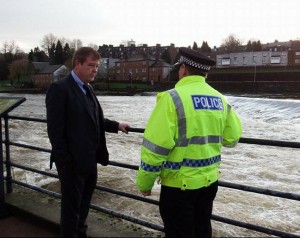SUBMERGE offered The Stove the opportunity to imagine a Dumfries of the future—a future predicted to be up to twice as wet by the end of this century.
As we prepared for SUBMERGE, our local council unanimously voted for a plan to build a physical structure along the edge of the River Nith, aiming to hold back the surges in this spate river and prevent the flooding that has been a feature of the town since records began. Hard as we searched, we could not identify the longer-term vision for the town that the barrier plan was intended to align with—how did the barrier contribute to a future for Dumfries, we wondered? The only answer we could ascertain was that it aimed to make a small area of the town more attractive to property developers. The strategy of attempting to attract private investment to revitalise the town has been the mantra for the past 20 years; however, it has not been successful and appears increasingly questionable amid the decline of 20th-century capitalism, which is failing to deliver well-being for the majority of the population in Scotland.
The Stove issued a call for people to join a group that would take an alternative approach and imagine a future where increased rainfall, sea levels, and river surges could be seen as an opportunity. We sought to reimagine Dumfries as a River Town—a place that embraced its environment, a place that Lives With Water.
In this plan, the banks of the River Nith are rewilded as riverbank through the centre of town. These new spaces are integrated with existing green spaces adjacent to the river to create a green corridor along the Nith, which is utilised for a combination of food and energy production, leisure, culture, and education.
“The commercial district of the town centre is condensed and centres on its traditional functions: serving as a market for local producers, a meeting place, and a centre for culture and heritage. As the transport hub for the region, Dumfries acts as the gateway linking national and international relations to the broader region of South West Scotland.
The area immediately surrounding the High Street and Market Square is converted to residential use, with urban smallholders and makers capitalising on the proximity to the market for their excess production, bringing vitality to the town centre throughout the day and night.
This vision was presented in a document titled ‘We Live With Water’, which was written from the vantage point of Dumfries in 2065 and featured commentaries by local writers reflecting on the future from a retrospective perspective.
Richard Arkless MP visited his constituents in Dumfries on Monday, 7th December 2015, to inspect the aftermath of the flooding from the previous weekend. During his visit, he heard rumours of an alternative plan for the town and the river and obtained a copy of We Live With Water to take back to Westminster as a potential way forward for our town.
We Live With Water was coordinated by The Stove Network and included contributions from:
Katie Anderson
Kate Foster
Rita Pacheco
Alyne Jones
David Slater
Mike Bonaventura
Lee McQueen
Matt Baker
Mark Zygadlo
Ivor Gott
Stuart White
Mary Smith
Lauren Soutar
Rhiannon Dewar
Linda Powell
Katharine Wheeler
(and some anonymous writers)
























